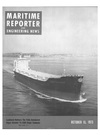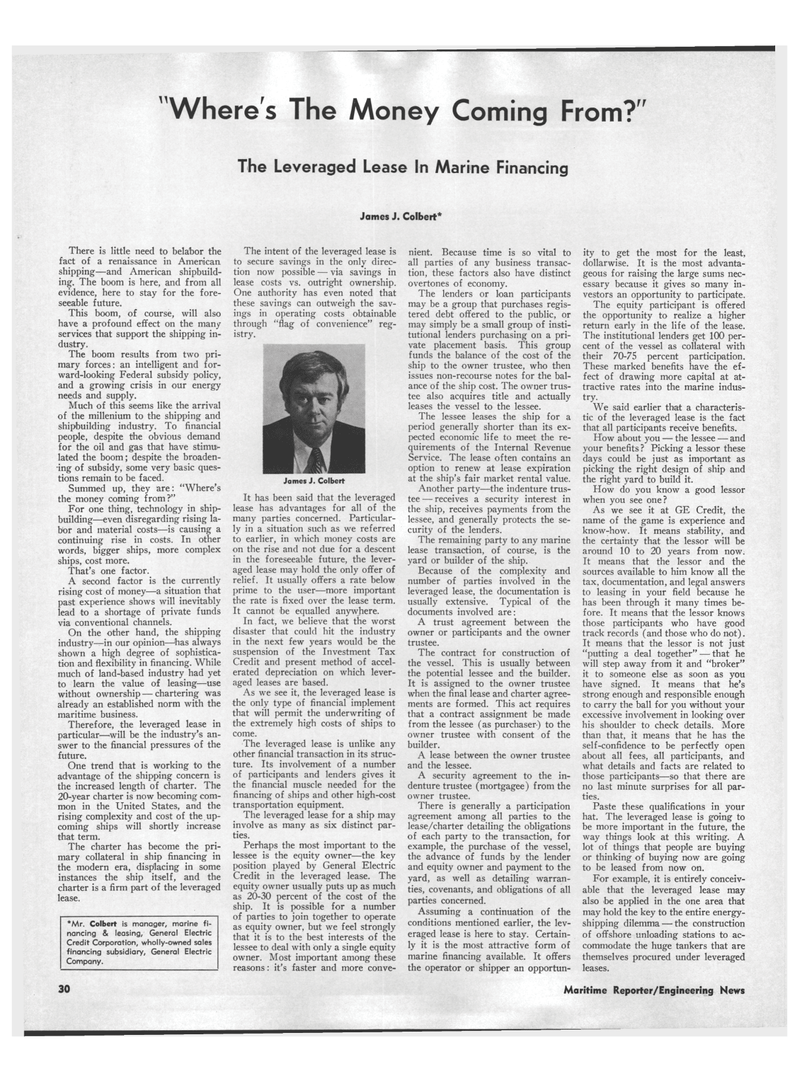
Page 24: of Maritime Reporter Magazine (October 15, 1973)
Read this page in Pdf, Flash or Html5 edition of October 15, 1973 Maritime Reporter Magazine
"Wheres The Money Coming From? '
The Leveraged Lease In Marine Financing
James J. Colbert*
There is little need to belabor the fact of a renaissance in American shipping—and American shipbuild- ing. The boom is here, and from all evidence, here to stay for the fore- seeable future.
This boom, of course, will also have a profound effect on the many services that support the shipping in- dustry.
The boom results from two pri- mary forces: an intelligent and for- ward-looking Federal subsidy policy, and a growing crisis in our energy needs and supply.
Much of this seems like the arrival of the millenium to the shipping and shipbuilding industry. To financial people, despite the obvious demand for the oil and gas that have stimu- lated the boom; despite the broaden- ing of subsidy, some very basic ques- tions remain to be faced.
Summed up, they are: "Where's the money coming from?"
For one thing, technology in ship- building—even disregarding rising la- bor and material costs—is causing a continuing rise in costs. In other words, bigger ships, more complex ships, cost more.
That's one factor.
A second factor is the currently rising cost of money—a situation that past experience shows will inevitably lead to a shortage of private funds via conventional channels.
On the other hand, the shipping industry—in our opinion—has always shown a high degree of sophistica- tion and flexibility in financing. While much of land-based industry had yet to learn the value of leasing—use without ownership — chartering was already an established norm with the maritime business.
Therefore, the leveraged lease in particular—will be the industry's an- swer to the financial pressures of the future.
One trend that is working to the advantage of the shipping concern is the increased length of charter. The 20-year charter is now becoming com- mon in the United States, and the rising complexity and cost of the. up- coming ships will shortly increase that term.
The charter has become the pri- mary collateral in ship financing in the modern era, displacing in some instances the ship itself, and the charter is a firm part of the leveraged lease. *Mr. Colbert is manager, marine fi- nancing & leasing, General Electric
Credit Corporation, wholly-owned sales financing subsidiary, General Electric
Company.
The intent of the leveraged lease is to secure savings in the only direc- tion now possible — via savings in lease costs vs. outright ownership.
One authority has even noted that these savings can outweigh the sav- ings in operating costs obtainable through "flag of convenience" reg- istry.
James J. Colbert
It has been said that the leveraged lease has advantages for all of the many parties concerned. Particular- ly in a situation such as we referred to earlier, in which money costs are on the rise and not due for a descent in the foreseeable future, the lever- aged lease may hold the only offer of relief. It usually offers a rate below prime to the user—more important the rate is fixed over the lease term.
It cannot be equalled anywhere.
In fact, we believe that the worst disaster that could hit the industry in the next few years would be the suspension of the Investment Tax
Credit and present method of accel- erated depreciation on which lever- aged leases are based.
As we see it, the leveraged lease is the only type of financial implement that will permit the underwriting of the extremely high costs of ships to come.
The leveraged lease is unlike any other financial transaction in its struc- ture. Its involvement of a number of participants and lenders gives it the financial muscle needed for the financing of ships and other high-cost transportation equipment.
The leveraged lease for a ship may involve as many as six distinct par- ties.
Perhaps the most important to the lessee is the equity owner—the key position played by General Electric
Credit in the leveraged lease. The equity owner usually puts up as much as 20-30 percent of the cost of the ship. It is possible for a number of parties to join together to operate as equity owner, but we feel strongly that it is to the best interests of the lessee to deal with only a single equity owner. Most important among these reasons: it's faster and more conve- nient. Because time is so vital to all parties of any business transac- tion, these factors also have distinct overtones of economy.
The lenders or loan participants may be a group that purchases regis- tered debt offered to the public, or may simply be a small group of insti- tutional lenders purchasing on a pri- vate placement basis. This group funds the balance of the cost of the ship to the owner trustee, who then issues non-recourse notes for the bal- ance of the ship cost. The owner trus- tee also acquires title and actually leases the vessel to the lessee.
The lessee leases the ship for a period generally shorter than its ex- pected economic life to meet the re- quirements of the Internal Revenue
Service. The lease often contains an option to renew at lease expiration at the ship's fair market rental value.
Another party—the indenture trus- tee — receives a security interest in the ship, receives payments from the lessee, and generally protects the se- curity of the lenders.
The remaining party to any marine lease transaction, of course, is the yard or builder of the ship.
Because of the complexity and number of parties involved in the leveraged lease, the documentation is usually extensive. Typical of the documents involved are:
A trust agreement between the owner or participants and the owner trustee.
The contract for construction of the vessel. This is usually between the potential lessee and the builder.
It is assigned to the owner trustee when the final lease and charter agree- ments are formed. This act requires that a contract assignment be made from the lessee (as purchaser) to the owner trustee with consent of the builder.
A lease between the owner trustee and the lessee.
A security agreement to the in- denture trustee (mortgagee) from the owner trustee.
There is generally a participation agreement among all parties to the lease/charter detailing the obligations of each party to the transaction, for example, the purchase of the vessel, the advance of funds by the lender and equity owner and payment to the yard, as well as detailing warran- ties, covenants, and obligations of all parties concerned.
Assuming a continuation of the conditions mentioned earlier, the lev- eraged lease is here to stay. Certain- ly it is the most attractive form of marine financing available. It offers the operator or shipper an opportun- ity to get the most for the least, dollarwise. It is the most advanta- geous for raising the large sums nec- essary because it gives so many in- vestors an opportunity to participate.
The equity participant is offered the opportunity to realize a higher return early in the life of the lease.
The institutional lenders get 100 per- cent of the vessel as collateral with their 70-75 percent participation.
These marked benefits have the ef- fect of drawing more capital at at- tractive rates into the marine indus- try.
We said earlier that a characteris- tic of the leveraged lease is the fact that all participants receive benefits.
How about you — the lessee — and your benefits? Picking a lessor these days could be just as important as picking the right design of ship and the right yard to build it.
How do you know a good lessor when you see one?
As we see it at GE Credit, the name of the game is experience and know-how. It means stability, and the certainty that the lessor will be around 10 to 20 years from now.
It means that the lessor and the sources available to him know all the tax, documentation, and legal answers to leasing in your field because he has been through it many times be- fore. It means that the lessor knows those participants who have good track records (and those who do not).
It means that the lessor is not just "putting a deal together" — that he will step away from it and "broker" it to someone else as soon as you have signed. It means that he's strong enough and responsible enough to carry the ball for you without your excessive involvement in looking over his shoulder to check details. More than that, it means that he has the self-confidence to be perfectly open about all fees, all participants, and what details and facts are related to those participants—so that there are no last minute surprises for all par- ties.
Paste these qualifications in your hat. The leveraged lease is going to be more important in the future, the way things look at this writing. A lot of things that people are buying or thinking of buying now are going to be leased from now on.
For example, it is entirely conceiv- able that the leveraged lease may also be applied in the one area that may hold the key to the entire energy- shipping dilemma — the construction of offshore unloading stations to ac- commodate the huge tankers that are themselves procured under leveraged leases. 14
Maritime Reporter/Engineering News

 23
23

 25
25
